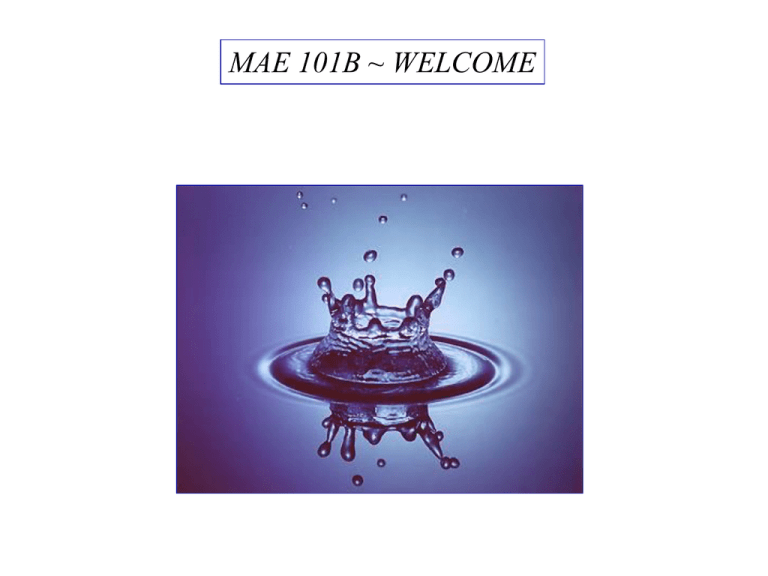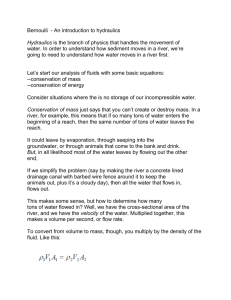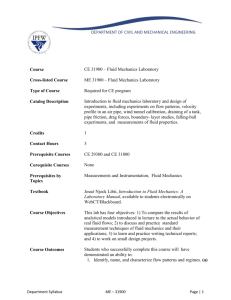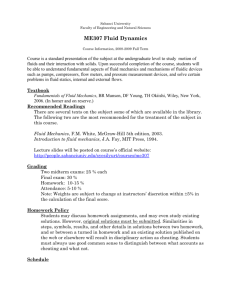Introduction
advertisement

MAE 101B ~ WELCOME
MAE 101B
REQUIRED TEXT
Chapter 8: Internal Incompressible
Viscous Flow - Sections 8.1-8.8
Chapter 9: External Incompressible
Viscous Flow – Sections 9.1-9.8
Chapter 11: Introduction To Compressible Flow – Sec. 11.1-11.4
Chapter 12: Compressible Flow
Sections 12.1-12.5
exploring a series of paradoxes…
Paradoxes:
For internal flows:
Pipe flow theory predicts p proportional to uavg but for most
experiments not so!
For external flows:
Usually an increase in velocity accompanied by an increase in
drag, but not always!
Usually surface roughness increases drag, but not always!
Usually streamlining decreases drag, but not always!
For compressible flows:
Usually reducing duct area increases velocity, but not always!
Usually friction results in velocity decrease, but not always!
Usually heat addition results in temperature increase,
but not always!
19231943
1934
HYDRAULICS
18871922
HYDRAULICS
1938
19501965
Hydrodynamics- term
to comprise the two
introduced in 1733 by Daniel Bernoulli
sciences of hydrostatics and hydraulics.
1744 D’Alembert’s Paradox
Hydor = water + aulos = tube
~200 BC term hydraulics coined
Fluide = that which flows
1938
In 1744 D’Alembert, assuming potential flow, deduced his famous paradoxical result that a
moving sphere does not encounter any resistance to its motion. D’Alembert realized the
contradiction between his mathematical result and experimental fact and knew that the premises
of the theory must be at fault. (Indeed he consistently emphasized the supremacy of experiment
over theory and his further investigations were mainly experimental).
1934
Tietjens and Prandtl ~
Fundamentals of Hydro- and Aeromechanics
1950
In Summary ~ Hydraulics
~ a large empirical subject mainly based on
formulae and data sheets developed in light of
experiments and experience by civil and
mechanical engineers.
~ valuable for dealing with problems arising in
the design of fluid machinery, ships, piping
systems, etc.
~ provided little theory from which formulae
could be justified and confidently generalized.
{There is nothing more practical than a good theory - Hoerner}
In Summary ~ Classical Hydrodynamics
~ given certain seemingly reasonable assumptions,
governing equations known, so much mathematics
can be brought to bear.
~ reasonable accurate description for the motion
of waves, jets, and lift if no separation.
~ lift is predicted if circulation is postulated but can
say nothing about how circulation arose, predicts no
drag, predicts linear dependence of pressure and Uavg
in pipe flow.
aside
arguably one of the finest fluids book
1738
An Anatomical Study of the Motion of the Heart
and of the Blood in Animals – William Harvey (1628)
“When an artery is punctured the blood
would be seen spurting with violence.”
“projected now to a greater, now to a lesser distance,
the tallest jet occurring when the heart contracts
1729 – Bernoulli reasoned that he height of the spurting blood was a direct
measure of its pressure in the artery. Bernoulli punctured the wall of a pipe with
a small hole and attached a glass straw. The height of the water in the straw
he realized is a measure of the flowing water’s pressure. (blood pressure was
measured this way until 1896 when sphygmomanometer was invented)
Daniel Bernoulli (1700-1782)
Hydrodynamica
•
•
•
•
•
published in 1738
contains correct analysis of water
flowing from a hole in a container
bases of kinetic theory of gases
force of jet on inclined plane
Bernoulli’s Equation
Johann Bernoulli – Hydraulica
• printed in 1739
• predated 1732
• largely based on Hydrodynamica
• author: Johann Bernoulli (father)
Despondent over his father’s plagiarism:
“I have no longer been able to persuade myself to work on anything
mathematical. My entire remaining pleasure is to work on some projects
on the blackboard now and then for future oblivion.”
MAE 101B
SUMMER II – 2006
BATTLE RYTHYM
CLASS SYLLABUS
Lectures:
M, W, F: 6:00 – 7:50
Rm 2204; Warren Lecture Hall
Instructor:
Dr. Jim Rohr (619) 553-1604
james.rohr@navy.mil
Office Hours – after class or by appt.
Teaching Assistant:
Julie Crockett
jcrockett@ucsd.edu
Discussion Sessions:
Thurs. - Rm 312, EBU2; 4:00 – 6:00 PM
Weds. / Fri. – after lecture
Rm 2204; Warren Lecture Hall
8:00 – 9:00 PM
CLASS SYLLABUS
http://maecourses.ucsd.edu
Prerequisites:
Textbook:
Website:
MAE 110A – Thermodynamics
MAE 101A – Introductory Fluid Mechanics
Introduction to Fluid Mechanics
by R.W. Fox, A.T. McDonald, P.J. Pritchard
John Wiley and Sons, Inc., Sixth Edition (2004)
See Class Web Sites at:
MAECOURSES.UCSD.EDU
http://maeweb.ucsd.edu/
Lecture notes, assignments, homework solutions,
templates for homework format.
CLASS SYLLABUS
Homework: Homework will be assigned every Monday
and due the following Friday. Homework must be submitted
before the beginning of class. No late Homework accepted.
Each homework problem will be graded thusly: 1 pt per
question awarded if “reasonable” effort.
Most of the problems on the quizzes, every Mon. ( or Weds.),
and final exam will be similar to the homework assignments,
examples in book and the problems I do in class. Homework
problems will be reviewed during Julie’s office hours and
posted on the website the evening that they are due.
CLASS SYLLABUS
Quizzes: Every Monday during last 1/2 hour
of class based on the previous homework. The
tests will be close book and closed notes but a
sheet of equations from the relevant chapter
(and posted on the web) will be provided. Each
test will be worth 15 points (60 points total).
CLASS SYLLABUS
Final Exam will be comprehensive and
based primarily on the homework.
You can bring two pages (9 ½” x 11”) of
equations, otherwise closed book and
closed notes.
Final is worth 30 points of your total grade.
Half on Chap. 12 / half on Chapters 8, 9, 11
CLASS SYLLABUS
Grading:
Home Work (4): 10%
Quizzes (4):
60%
Exam (1):
30%
CLASS SYLLABUS
Week 1: Aug. 7, 9, 11 –
Chapter 8, Sections 8-1 to 8-8
Week 2 & 3: Aug. 14, 16, 18, 21, 23, 25 –
Chapter 9, Sections 9-1, 9-2, 9-4 to 9-9
Week 4: Aug. 28, 20, Sept 1 –
Chapter 11, Sections 11-1 to 11-5
Chapter 12, Sections 12-1 to 12-2
Week 5: Sept 6, 8 –
Chapter 12, Sections 12-3 to 12-5
Sept. 9: Final Exam
(Blue indicates quiz day, red indicates final exam day)
RECOMMENDED BACK-UP
Other texts:
Fluid Mechanics
– White (McGraw Hill)
Boundary-Layer Theory
– Schlicting (McGraw – Hill)
Shape and Flow
- Shapiro (Anchor Books)
Elements of Gas Dynamics
- Liepmann & Rochko (Wiley)
Gas Dynamics
- John (Allyn andBacon)
Introduction to Flight
Intro. To Fluid Mechanics
- Anderson
- Nakayama & Boucher (Arnold)
Engines, Energy and Entropy
- Fenn (Freeman and Company)
“Although fluid mechanics is a challenging and complex
field of study, it is based on a small number of principles,
which in themselves are relatively straight forward. The
study of fluid mechanics is undoubtedly difficult but it can
also become a profound and satisfying pursuit for anyone
with a technical inclination.” Alexander J. Smits
WHERE IS
WALDO?
aside….
“The unsung hero
of human history
was, of course,…
The Brain of Drains,
the Hub of Tubs,
the Power of Showers,
the Brewer of Sewers …
the humble plumber
W. Hodding Carter
if I could not be a prince, I would rather be a plumber
Edward – Prince of Wales
• plumbing around at least 7000 years
• 5000 BC. bamboo pipes in China
• 3000 BC. earthenware pipes in India & Pakistan
• 500 BC lead pipes in Greece
• plumbum Latin word for lead /
plumarius ~Roman word for plumber
(100 AD - 1 million people in Rome : ~ 300 gallons per day per household)
• 1128 - lead plumbing through Paris
• 1237 - lead (and wood) plumbing through London
• 1870 – modern toilet
(~ 2 million children in India alone die of diseases
due in part to poor sewage disposal)
THE END
In A.D. 97, Rome’s great water commissioner Sextus Julius Frontinus boasted:
“Will anybody compare the idle pyramids or those other useless
though much renowned works of the Greeks with these aqueducts?”
Fluid mechanics known
by Romans:
• Water flows downhill,
never uphill
• The greater the diameter,
the larger amount of water
a pipe can deliver





